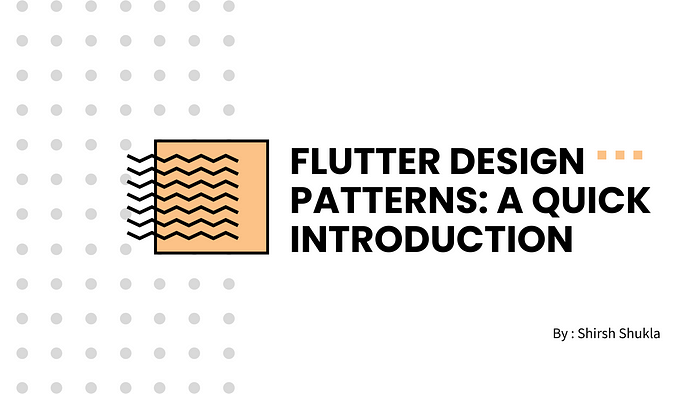Flutter Design Patterns: A quick introduction
The Time-Saving Strategies and Best Practices for Flutter App Design

To begin this article, let’s explore the concept of design patterns and their significance. To better grasp this, let’s draw an analogy. Imagine yourself as a chef who has recently launched a new restaurant. Suddenly, a Critic arrives and criticizes the quality of your food. In response, you strive to enhance the food’s quality by continuously experimenting with different techniques. For instance, you may attempt to use less salt in one instance, and then try other variations in subsequent attempts. Throughout this process, you diligently document all the recipes you create. Eventually, your efforts culminate in achieving the desired taste.
now you stop improving the food quality this analogy in terms of code is exactly what a design pattern is supposed you encounter some coding problems again and again in your project being a programmer you don’t want to rewrite code you believe in dry principle meaning don’t repeat yourself that’s when you use these design patterns if you’ve coded on a big project you’ve probably even used some of the design patterns.
In order to discuss an issue and its resolution, it is essential to examine its fundamental lexicon. Thus, when a programmer needs to converse with a fellow programmer regarding a solution to a specific problem, they can simply suggest utilizing the Singleton pattern, as opposed to stating the need for a class to have a sole instance accessible throughout the entirety of our codebase. These design patterns facilitate not only interpersonal communication but also enhance code comprehension, offering reliable and efficient solutions that eliminate the risk of subpar software design.
this series is based on a book called Design patterns elements of reusable object-oriented Software if you want to get ahead and know much more…
I’m seeing this because the design patterns we are going to take a look at in a future article are being used for more than three decades in different object-oriented programming languages and it’s hard to find an object-oriented system that doesn’t use at least a couple of the patterns.
you are going to take a look at if not all of them the design patterns are segregated into three parts creational, structural, and behavioral

these will be explained in later articles as they will be best understood when an example of one of the design patterns that fall under the particular category is understood.
Our next articles will discuss each of these categories in more detail, as well as what you want in those articles, please comment below also keep in mind that “Design” here does not mean UiUx Design, but rather software development and design. The advantage of Design Patterns is that they are not specific to any one programming language or framework, and they can be developed, implemented, and used across multiple languages. As part of some research, I obtained all the information in this article from a variety of websites, so if you find any errors or misdirected links, please let me know.
If you got something wrong? Mention it in the comments. I would love to improve. your support means a lot to me! If you enjoy the content, I’d be grateful if you could consider subscribing to my YouTube channel as well.
I am Shirsh Shukla, a creative Developer, and a Technology lover. You can find me on LinkedIn or maybe follow me on Twitter or just walk over my portfolio for more details. And of course, you can follow me on GitHub as well.
Have a nice day!🙂
